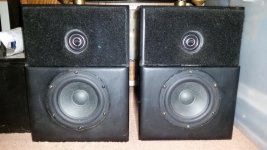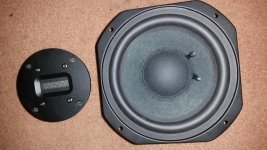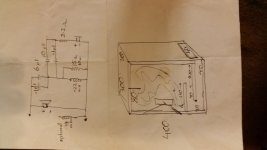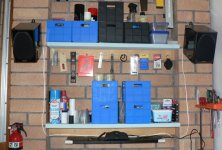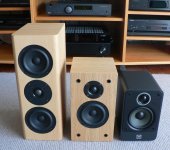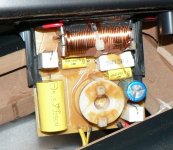I had a need for a small 3 litre speaker and researched and modelled drivers available in Oz. There was very little available that would meet the targets of the design with the best being SB12NRX but had used that previously on 2 speakers (one a Jeff Bagby design). In the end I found a new pair of Q Acoustics 2010i that I bought for AU$159 (superseded model).
I couldn't buy drivers and crossover parts for that price so the option of a DIY speaker was a waste of time and money. The Q Acoustics are more than satisfactory and do not give much away to Jeff Bagby's Sopranos which are a larger speaker.
So there are times where DIY is not worth the effort and after designing and building 50+ speakers it was a pleasure to just be able to pull one out the the box and not get covered in MDF dust etc. Of course DIY can also be about the journey but I've done enough miles.
I couldn't buy drivers and crossover parts for that price so the option of a DIY speaker was a waste of time and money. The Q Acoustics are more than satisfactory and do not give much away to Jeff Bagby's Sopranos which are a larger speaker.
So there are times where DIY is not worth the effort and after designing and building 50+ speakers it was a pleasure to just be able to pull one out the the box and not get covered in MDF dust etc. Of course DIY can also be about the journey but I've done enough miles.
Sometimes it's not, depends on your wherabouts and timber stash. Cover yourself with real wood dust rather than mdf. This one is available again.
https://meniscusaudio.com/product/caritas-full-kit-pair/
https://meniscusaudio.com/product/caritas-full-kit-pair/
I agree with the high cost of diy in comparison with ' off the shelf ' commercial speakers but surely ,for me at least , the satisfaction comes with the knowledge that what you build yourself has been done with care , enthusiasm and love not to mention the end result often being unique and not a product created by soul-less anonymous robots in some far off factory whose only real concern is making a profit.
When i first got into hi-fi many products were still built ' by hand ' by enthusiastic people
that had a passion for their product/s , sadly those days are, with the odd exception ,long past but given a choice i know which ones would get my money.
When i first got into hi-fi many products were still built ' by hand ' by enthusiastic people
that had a passion for their product/s , sadly those days are, with the odd exception ,long past but given a choice i know which ones would get my money.
+1 Konzentr8
DIY gives you the chance to make things better, which is not always cheaper.
You can actually choose what wire, caps, coils and drivers you will be using. You can choose your finish to blend into your living space or to stand out.
Speakers that will serve as background noise in your work place can be cheap as long they are not really bad sounding. But the ones that i sit in front of trying to hear every last detail in music - they have to be flat power response, good waterfall and low distortion - and every one of these requirements is positively correlated with price and craftsmanship. That doesn't mean that drivers have to be super expensive to be good, but you can't make chicken salad out of chicken sh*t.
DIY gives you the chance to make things better, which is not always cheaper.
You can actually choose what wire, caps, coils and drivers you will be using. You can choose your finish to blend into your living space or to stand out.
Speakers that will serve as background noise in your work place can be cheap as long they are not really bad sounding. But the ones that i sit in front of trying to hear every last detail in music - they have to be flat power response, good waterfall and low distortion - and every one of these requirements is positively correlated with price and craftsmanship. That doesn't mean that drivers have to be super expensive to be good, but you can't make chicken salad out of chicken sh*t.
Last edited:
Why specifically did want 3 litre speakers?
Assuming 15mm walls, the Q Acoustic speakers are 4 litres, internal volume, 7 litre external volume.
I agree about price for small speakers in particular. My sister has a pair of those 2010i speakers and I like them a lot. And with my limited workshop facilities I could never make a pair of speakers to look as nice. But I like the subjectivity that diy allows. I fiddle around until I get the sound I like.
Assuming 15mm walls, the Q Acoustic speakers are 4 litres, internal volume, 7 litre external volume.
I agree about price for small speakers in particular. My sister has a pair of those 2010i speakers and I like them a lot. And with my limited workshop facilities I could never make a pair of speakers to look as nice. But I like the subjectivity that diy allows. I fiddle around until I get the sound I like.
I had a had enough experience about 8 years ago. Working on a TL 14 litre 2 way with Silver Fute 5 1/4 in Bass/mid and @ that time Vifa XT 25 tweeter.
No matter what I did I couldn't get the Crossover right and it sounded mediocre @ best. After herculean effort time $ money.
So I quit building for a time. About 2 years. Then a friend came up
with a novel new implementation for the crossover. I was hardly inspired @the time & took about 6 months before I could be bothered implementing the mods. It was much MUCH better!
The changes were quite simple. The results dramatic. That was enough to inspire me once more. The momentum slowly came back & now I LOVE it. I'm on a Disability Support Pension & grabbing a bargain @ Garrage or car boot sale & bringing an old retro speaker back to life and better than new helps keep me sane and helps me survive. As a buisness it would be a fail but as a paying hobby a success. For me there is a deep sense of satifaction in restoring speakers. There is also the satisfaction of helping someone else appreciate music more by what you do because its done right. If you are thinking only about the bottom line that is perhaps at least for me missing much of a whole bunch of points.
Take a break and gain a different perspective. Might be the best thing you ever did for yourself to save your hobby. It was for me
Cheers
No matter what I did I couldn't get the Crossover right and it sounded mediocre @ best. After herculean effort time $ money.
So I quit building for a time. About 2 years. Then a friend came up
with a novel new implementation for the crossover. I was hardly inspired @the time & took about 6 months before I could be bothered implementing the mods. It was much MUCH better!
The changes were quite simple. The results dramatic. That was enough to inspire me once more. The momentum slowly came back & now I LOVE it. I'm on a Disability Support Pension & grabbing a bargain @ Garrage or car boot sale & bringing an old retro speaker back to life and better than new helps keep me sane and helps me survive. As a buisness it would be a fail but as a paying hobby a success. For me there is a deep sense of satifaction in restoring speakers. There is also the satisfaction of helping someone else appreciate music more by what you do because its done right. If you are thinking only about the bottom line that is perhaps at least for me missing much of a whole bunch of points.
Take a break and gain a different perspective. Might be the best thing you ever did for yourself to save your hobby. It was for me
Cheers
Attachments
I built a very good pair of speakers years ago using 2 4" woofers 3" mid tweeter and 1" polycarb dome. Add a sub and these are excellent.
I stopped thinking of building more after I tried current amps out.
The BestBuy $129 pair i have are mediocre on a standard amp but absolutly spectacular on a P-P tube amp.
I now concentrate on amplifiers and adjustments
Audiopath, I have been running the tweeter accoss the woofer inductor with very good results
I stopped thinking of building more after I tried current amps out.
The BestBuy $129 pair i have are mediocre on a standard amp but absolutly spectacular on a P-P tube amp.
I now concentrate on amplifiers and adjustments
Audiopath, I have been running the tweeter accoss the woofer inductor with very good results
Last edited:
Hi stocktrader200 funny you should mention that as one of my next projects will do the same. Plagerised off Adelaide Speakers with Edwards (the propieters permission). Rates as one of the sweetest 2 ways I've ever heard. There are precious few speakers that work & sound correct that way but when they do they are usually something quite special.
Attachments
Not this little black duck. As illustrated is how she runs. I like it best without the .33 option and I use no bypass caps as I run Audyn, Auricap or Mundorf Supreme. Jantzens best non inductive resistors or Mundorf. With such a simple circuit it makes the quality of XO componentry known. Edward no longer uses this bass/mid driver in his commercial designs so I am free to share.
Attachments
Why specifically did want 3 litre speakers?
Assuming 15mm walls, the Q Acoustic speakers are 4 litres, internal volume, 7 litre external volume.
I wanted a small wall mounted speaker for my tiny postage stamp size workshop. Since these would be near field, I only wanted an F3 around 70Hz. The Q Acoustics are too good for there so threw in a pair of Denon SC-N5 I had laying around.
From the specs, the Q Acoustics 2010i are 3.3 litres effective volume as you have to exclude the bottom terminal block, brace, port, drivers, xo.
The 2010i are going to replace the Sopranos in my study as they work better in there (3m x 4m room), especially in the mids. I'm not saying they are better but are better suited as I can't give the Soprano the required distance from the back wall which makes the mids a bit recessed. If I need more bass, I can turn on a small sub but for most music, not required.
The 2010i are very small and in the pic from left to right, 9 litres, 4.7 litres, 3.3 litres.
Attachments
I'd never use timber to build a speaker due to instability and cracking. Baltic birch plywood is very good but hard to get and very expensive in Oz and have to buy a 1.2m x 2.4m sheet.
That speaker at Meniscucaudio is 14 litres is a bit larger than than 3 litre target. With shipping and exchange rate the drivers and xo would be much more than the 2010i. Even so it's very good value but a limited run charity special using surplus drivers.
DIY does have it's advantages as you can voice the speaker to suit your tastes, room, equipment, get creative and is the reason I went into this hobby 15 years ago. DIY is not cheap and can be more expensive than commercial offerings but there is a high level of satisfaction. You get to use some great drivers from Scan Speak, SB Acoustics, SEAS etc. You can waste a lot on xo parts but I liked Mundorf white M-Caps and Jantzen inductors which are reasonably priced.
I'm however at a stage where building is done on auto pilot and no longer get joy out of the actual building so have moved onto other pursuits. If I have a need I have no problem designing and building another (such as drivers from the Soprano will need a new use) but I will keep the commercial option open.
50+ speakers designed and built, 20+ amplifiers built, AU$50,000+ means a time to stop.
That speaker at Meniscucaudio is 14 litres is a bit larger than than 3 litre target. With shipping and exchange rate the drivers and xo would be much more than the 2010i. Even so it's very good value but a limited run charity special using surplus drivers.
DIY does have it's advantages as you can voice the speaker to suit your tastes, room, equipment, get creative and is the reason I went into this hobby 15 years ago. DIY is not cheap and can be more expensive than commercial offerings but there is a high level of satisfaction. You get to use some great drivers from Scan Speak, SB Acoustics, SEAS etc. You can waste a lot on xo parts but I liked Mundorf white M-Caps and Jantzen inductors which are reasonably priced.
I'm however at a stage where building is done on auto pilot and no longer get joy out of the actual building so have moved onto other pursuits. If I have a need I have no problem designing and building another (such as drivers from the Soprano will need a new use) but I will keep the commercial option open.
50+ speakers designed and built, 20+ amplifiers built, AU$50,000+ means a time to stop.
Rabbitz, working on the amps and preamp deliver the most bang now as modern stuff is really cheap or very expensive for good quality.
I have gutted 2 pioneers. An Sx3700 and a Sx780
the 780 is getting tuner upgrades, Lichtstark Mosfet amplifier , tube preamp driving passive tone controls , OPA2134 pre (volume Pot) amplifier, New phono RIAA preamp.
The 3700 got Tuner updates,Mosfet Current feedback amp, tube preamp, OPA2134 tone controls, Iphone mp3 smoothing input.
Both are close to 20K equipment now
I will add a surround board to the 780 which provides 5.1 using inexpensive computer speakers for the rear ,center and sub.
Lichtstark detailed here
http://www.diyaudio.com/forums/solid-state/277087-revisiting-some-old-ideas-1970s-ips-ops-187.html
I have gutted 2 pioneers. An Sx3700 and a Sx780
the 780 is getting tuner upgrades, Lichtstark Mosfet amplifier , tube preamp driving passive tone controls , OPA2134 pre (volume Pot) amplifier, New phono RIAA preamp.
The 3700 got Tuner updates,Mosfet Current feedback amp, tube preamp, OPA2134 tone controls, Iphone mp3 smoothing input.
Both are close to 20K equipment now
I will add a surround board to the 780 which provides 5.1 using inexpensive computer speakers for the rear ,center and sub.
Lichtstark detailed here
http://www.diyaudio.com/forums/solid-state/277087-revisiting-some-old-ideas-1970s-ips-ops-187.html
Last edited:
I think it's the price point of the speakers of interest. DIY will never able to compete with book shelf speakers that cost about US $300 due to economy of scale. But as you go higher up in price, it makes more sense. For example you can build a pair of stand mount using ScanSpeak revelator woofers and tweeters for about US$1500 with the best xover components and if done correctly, they will sound just as good as any commercial speakers that will cost a lot more money. I've seen some high end stand mount that cost US$5000 or more that may not even use high quality xover components. Things get more complicated with floor standers. Some of these high end will cost at least US$ 10K and it's not uncommon that some will cost $20K or more. If you have the skills, you can build a world class 4-way for 4-5K and still a lot less expensive than those high end.
Besides costs, you may not even like the sound of those speakers. I found that a lot of commercial speakers are voiced too bright. And if you want to build a good 5.1 surround system, it can get complicated.
And of course all of this only make sense if one has the skills and I know that is a big IF. Of course there are other intangible factors such as 1st, 2nd order xover ..., veneer finish, size, shapes, .... so on. And I guess if you're into music then it's not at all difficult to understand why diy.
Besides costs, you may not even like the sound of those speakers. I found that a lot of commercial speakers are voiced too bright. And if you want to build a good 5.1 surround system, it can get complicated.
And of course all of this only make sense if one has the skills and I know that is a big IF. Of course there are other intangible factors such as 1st, 2nd order xover ..., veneer finish, size, shapes, .... so on. And I guess if you're into music then it's not at all difficult to understand why diy.
Of course. Just swap the cap if you have them on shelves already!
Measure the stock one before, but I'm sure at this low price, the cap is a standard one rebadged QAcoustic maybe and with a standardised capacitance value +/- 10 % (not wanted, just factory concistency)! ! As far I know they just use cheap MKP at QAcoustic (as division of B&W ?)
! As far I know they just use cheap MKP at QAcoustic (as division of B&W ?)
But you can be pleased by a simple optimisation... It's just tweaking and must stay cheap.
Measure the stock one before, but I'm sure at this low price, the cap is a standard one rebadged QAcoustic maybe and with a standardised capacitance value +/- 10 % (not wanted, just factory concistency)!
But you can be pleased by a simple optimisation... It's just tweaking and must stay cheap.
You can't compete with mass manufacturing. I personally only consider DIY if I aim to compete with speakers starting at 1500€ retail. (400-600€ build budget).If I don't want to spend at least 400€ in parts I'll go check second hand sites. Lost of really good deals to be found.
You should swap the stock cap tweeter of the Acoustic Q1010i by a jantzen Audio one... and maybe it will sound as good if not better than a Troel's !
I couldn't find anything on the crossover in the Q Acoustics 2010i so had a look (see pic). Looks like a LR2 or similar but not sure what the 2 0.33uF caps are doing as I didn't look at the traces under the PCB. At least they have made the effort unlike the other budget speakers that just use a cap on the tweeter. Use of a 5.6uF MKP in series with the tweeter is a good step and the 10uF electrolytic to ground on the woofer is fine. The box is well constructed and has a cross brace as well as a driver cutout glued to the top panel (I use driver cutouts for similar uses).
I did alter the CR network in my Sopranos to make the mids more to my liking.... much better now and closer to the mids in my SB12NRX MTM.
Attachments
- Status
- This old topic is closed. If you want to reopen this topic, contact a moderator using the "Report Post" button.
- Home
- Loudspeakers
- Multi-Way
- Sometimes building a budget small speaker is not worthwhile
